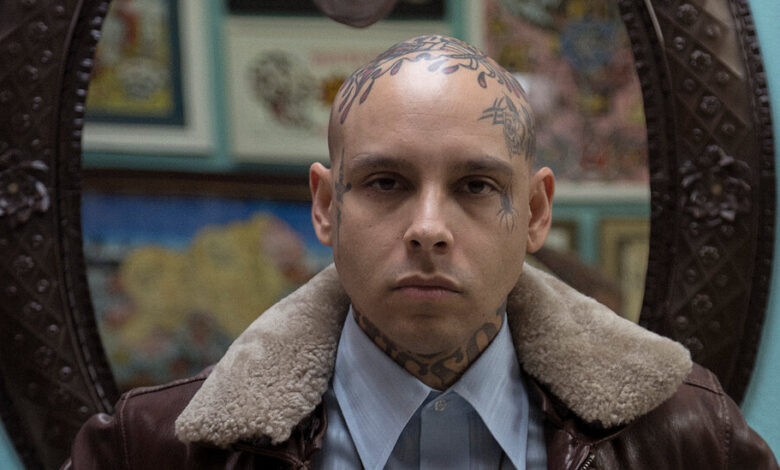How a #MeToo Case Collapsed in the Tattoo Industry

It was past midnight in a dark bar in Bushwick last summer, and the man at the counter was furious. Short and covered in ominous tattoos — including one across his forehead that read “I WANT TO KILL YOU” — the man accused the bartender of using the wrong liquor in his drink. Incensed, he slammed his glass down, grinding the bar to a halt.
The crowd inside Post No Bills, a nondescript haunt frequented by Brooklyn creative types, identified the source of the disturbance immediately. The man, Isaiah Camacho, was a roving tattoo artist known as “Toothtaker,” and accusations against him had circulated in whisper networks for years. On the night that he surfaced in Brooklyn, he was wanted in Arizona on charges that included sexually assaulting women he had tattooed.
Asked to leave the bar, Mr. Camacho refused, breaking glasses and lunging at the crowd with a corkscrew. When the bartender pulled out a baseball bat, Mr. Camacho finally left, swearing to return and “spray” the place with bullets, according to someone who heard him.
Rattled, the bartender locked the door, keeping the crowd huddled inside. Finally, an hour later, they slowly trickled out. No one filed a police report; this was not the kind of crowd that called the cops.
By the next day, warnings about Mr. Camacho were ricocheting around social media, urging other establishments not to serve him: “There is a monster in our midst & he calls himself TOOTHTAKER,” one widely shared message read.
Just days later, though, the police caught up with Mr. Camacho. He was arrested on a fugitive warrant and sent to Rikers Island until he was transported back to Arizona. After more than a decade of accusations, witnesses prepared to testify and court hearings commenced.
Then the case fell apart.
To those who say they have been attacked by Mr. Camacho, the story of Toothtaker represents a new frontier in the #MeToo movement — one that has proved difficult to navigate.
The push to hold powerful men accountable for sexual misconduct has swept through Hollywood studios and corporate boardrooms, but it has struggled to take root in places like the insular underground tattoo industry, where pervasive stereotypes and a culture of masochism have often protected or even rewarded abusive and predatory behavior.
The collapse of the case against Mr. Camacho — despite numerous accusers willing to testify against him — illustrates the challenges that women working or living within subcultures still face in bringing a cultural reckoning into a courtroom.
The New York Times spoke with more than two dozen people familiar with Mr. Camacho’s case, including prosecutors, tattoo artists, accusers and former friends. The Times also reviewed hundreds of pages of court documents, internal emails from three Arizona prosecutors’ offices and police reports — including a 50-page detective’s brief from the Tucson Police Department that contained detailed allegations of rape and sexual assault.
Taken together, the accounts tell an unsettling story of power, predation, and the surprisingly blurry line between artistry and abuse. And, prosecutors say, Mr. Camacho’s story underscores the challenge of prosecuting cold case sex crimes, where the passage of time renders memories unsteady and erodes physical evidence.
“We do believe they’re victims. We do believe their story,” said Kent Volkmer, the Arizona prosecutor who dropped Mr. Camacho’s case. “We just don’t believe, given all the inconsistencies, that we can convince a jury.”
The Great Read
More fascinating tales you can’t help but read all the way to the end.
Mr. Camacho did not respond to multiple attempts to contact him by telephone, email, text message and through certified mail. A lawyer who had represented him in the past said Mr. Camacho was no longer a client, and declined to comment.
Edgy, Enigmatic and Violent
Diana Williams first met Isaiah Camacho around 2006, when she was still in high school and he was an up-and-coming tattoo artist, blazing through the Tucson art scene. At his tattoo shop, Staring Without Caring, Mr. Camacho had garnered a rabid following through his distinct style — psychedelic and bold, with heavy line work and occult influence.
“I built this friendship with him,” Ms. Williams said.
His magnetism was about more than his artwork. Inside a subculture where the threat of real danger was not just accepted but often alluring, Mr. Camacho presented himself as an outlaw.
“He was this enigmatic man that you felt edgy around,” said Kaia Lacy, who first met Mr. Camacho around 2006, when he tattooed her forearm.
The air of menace helped make him a star, but his persona appeared to fit his personality. He was prone to episodes of gratuitous violence and bullying, and he ridiculed apprentices and clients.
Once, he beat a man with a wrench, according to police documents. In another instance, he crashed a female employee’s art show and set her work on fire. In interviews at the time, he bragged about popping out another man’s eyeball in a fight, and would later be convicted of three felonies, including for attacking a man with a bat.
On Mr. Camacho’s workstation, he kept a human tooth that he told clients he had taken from a man’s mouth by force — a story that earned him his grim nickname: Toothtaker.
“He was part of the new cult of celebrity,” said Dustin Kiskaddon, a tattoo artist who produced a doctoral thesis on the inner workings of the industry. “He sort of offered an image that I think a lot of people, myself included, would often gravitate toward.”
After Ms. Williams graduated from high school, she remained friendly with Mr. Camacho, who had tattooed her hands and arms. One night, years into their friendship, Mr. Camacho offered to give Ms. Williams, then 21, a ride home from the bar where she worked.
According to her account, police documents and court papers, Ms. Williams accepted the offer, but became uneasy when Mr. Camacho failed to turn down her street. They instead arrived at Mr. Camacho’s house, but when she tried to leave after one drink, she said, he blocked her from the front door, groped her, dragged her to his living area and raped her. As a Black woman in an overwhelmingly white state, she said she feared calling the police.
Ms. Lacy also described suffering at Mr. Camacho’s hand. The episode began during a tattoo session, when Mr. Camacho, out of Ms. Lacy’s field of vision, tattooed the very colors she had told him not to — an experience echoed by four other former associates of Mr. Camacho, who say he pressured people to get tattoos they didn’t want.
Furious, Ms. Lacy confronted Mr. Camacho, but he dismissed her concerns, claiming he knew better, she said. She later convinced a different artist to cover up part of the tattoo — a violation of the unwritten code that exists between tattoo artists.
Years later, Mr. Camacho, who had learned about her altering the tattoo, remembered the slight. He confronted Ms. Lacy outside a Tucson bar, putting his hand against her throat, pinning her against the wall and saying he was going to rape her, Ms. Lacy said. In another instance, he saw her at a bar, grabbed her by the throat and forcibly kissed her. She reported the incident to Tucson police, but nothing came of it.
Though some privately empathized with Ms. Williams and Ms. Lacy, their stories — and others — did not dim Mr. Camacho’s star.
“I had friends who I was close with who were just like, ‘Well that’s just Isaiah,’” Ms. Lacy said. “It was really hard feeling like it was dismissed because he had clout or was artistic.”
By 2013, Mr. Camacho was one of the most sought-after traveling tattoo artists in the country, and he seemed to delight in the rumors that dogged him, eventually releasing rap songs that ridiculed his accusers and issuing threats on Instagram.
In a 2013 interview with Tucson Weekly, Mr. Camacho dismissed the accusations against him, saying he only acted out against people who deserved it.
“I don’t really regret any of the stuff I’ve done,” he said.
An Industry Upended
Tormented by Mr. Camacho’s continued rise, Ms. Williams lived quietly with her experience for years, believing a reckoning would never come.
Then, in 2019, years after the #MeToo movement swept across the country, something changed in the tattoo industry. Clients and artists began calling out fellow tattooers for abusive practices.
Artists who had been protected by the industry’s insularity found themselves ostracized — including Mr. Camacho, who was the subject of an anonymous Instagram account called “Surviving Toothtaker,” which detailed the accusations against him. (A defiant Mr. Camacho would later adopt the phrase as the title of his 2020 rap album.)
For those who trained under him, Mr. Camacho came to represent a grave violation of the industry’s traditions.
“Every step of the process besides our technical abilities is just built on trust. You have to get consent from the client multiple times,” said Christine Riebock, who apprenticed under Mr. Camacho but left after seeing his behavior. “To not do that much, and then to abuse and take advantage of the trust that you’re getting, is just evil.”
The online accounts of Mr. Camacho’s behavior were chilling for people like Ms. Williams, who believed her experience existed in a vacuum. But in interviews with more than a dozen people who described disturbing or violent interactions with Mr. Camacho, many said they had feared coming forward.
Court and police records describe a series of accusations against Mr. Camacho. One woman, Anna Ray, said Mr. Camacho had stabbed her with a broken beer bottle around 2011 or 2012, after they had a verbal altercation at a party, an account that was corroborated through police documents and an eyewitness. Another woman, who was not identified by name in police and court records, said she believed Mr. Camacho sexually assaulted her in a restroom around the same time as Ms. Williams, though she acknowledged blacking out and not remembering parts of the episode.
Not long after the Instagram account surfaced, two Tucson Police Department detectives began to investigate, prompted by the descriptions of Mr. Camacho’s behavior on Instagram. By the summer of 2020, the Arizona Attorney General’s office had taken up the case.
‘In All Likelihood, We Will Dismiss’
Mr. Camacho was charged by a grand jury in May 2021 with more than a dozen felony counts, including sexual assault, aggravated assault and sex with a minor, with most of the charges stemming from between 2009 and 2013. After evading authorities for weeks, he was arrested and transferred back to Tucson, where he was released on bail.
Despite the potential testimony of dozens of victims and witnesses, the case against Mr. Camacho dissolved rapidly. According to two people familiar with the situation, the Arizona Attorney General’s office became concerned that a leading prosecutor on the case had sent sexual messages to someone he thought was a woman who worked as a bartender in Arizona. But prosecutors believed Mr. Camacho had been posing as the bartender in an effort to “catfish” the lawyer, according to an internal email obtained by The Times.
In August 2021, the Arizona Attorney General’s office sought to pass the case to local prosecutors in Pinal County, just south of Phoenix. But in emails reviewed by The Times, that office urged the Attorney General not to give them the case, saying they would likely drop it. The Attorney General’s office ordered them to take it anyway, and within weeks, the case was dismissed without prejudice. Mr. Camacho was freed.
In an interview, Kent Volkmer, the Pinal County Attorney, defended the decision. Almost all of the victims involved in Mr. Camacho’s case had been under the influence of alcohol or other substances at the time of their assaults, he said, and most had waited years before reporting to law enforcement. Most of the accounts could not corroborated; what witnesses could be found did not remember events the same way, he said.
“What I don’t want to do is revictimize victims, and say that ‘you’re not a pure enough victim, or a chaste enough victim,’” he said. But, he added, “To raise a he-said-she-said to beyond reasonable doubt is very, very difficult.”
The Arizona Attorney General’s office declined to comment on why it sought to transfer the case to a different prosecutor. In an email, a spokeswoman for the office defended its decision to seek an indictment against Mr. Camacho, but stressed that Pinal County and other prosecutors reserved the right to act independently.
Prosecutors in another jurisdiction — Pima County, which includes Tucson — say they are considering reopening the case, but now face challenges because the case was already dismissed elsewhere.
“That’s a hurdle of epic proportion,” said Laura Conover, the Pima County District Attorney, in an interview. She empathized with victims who felt failed by the system over the last two years, and said her office “is doing the best we can.”
Those who crossed Mr. Camacho’s path have found their own closure. Some have stayed in Tucson, others have moved away for good, like Ms. Williams, who left Arizona in February. Eager for a new start, she bought a one-way ticket to New York this spring.
A seamstress by trade, Ms. Williams had spent the decade since her assault working with hands that had been tattooed by Mr. Camacho. She is one of several women who said that for years, they struggled to find artists willing to cover the tattoos.
But one of Mr. Camacho’s former apprentices, Tommy Jimenez, knows the power of ink and reclamation.
“He tattooed for all the wrong reasons,” Mr. Jimenez said of his former boss. Based in Oakland, Calif., he now offers to cover up Mr. Camacho’s work — and the work of other abusive artists — for free.
In a tearful session in late 2020, Mr. Jimenez and Ms. Williams reconnected. Now, when she works at her sewing machine in Queens, the scars from Mr. Camacho’s tattoos are just barely visible, covered by colorful roses.
Kirsten Noyes contributed research.




